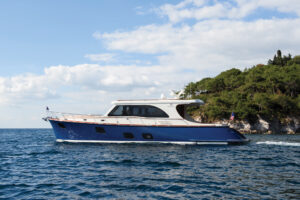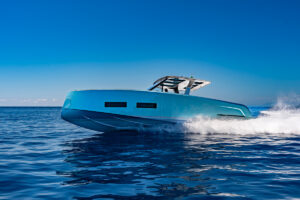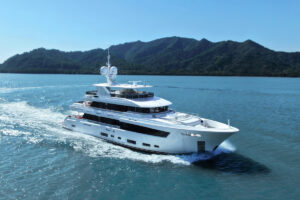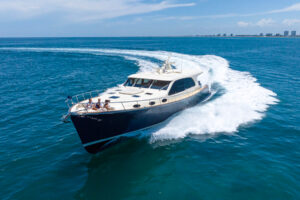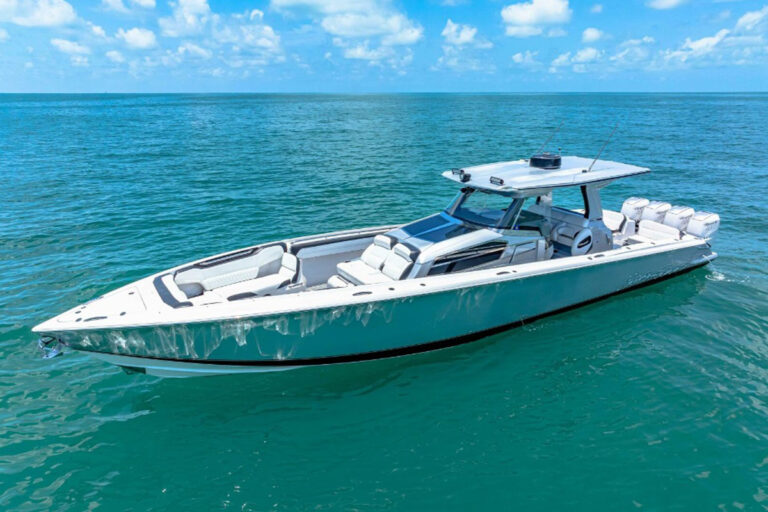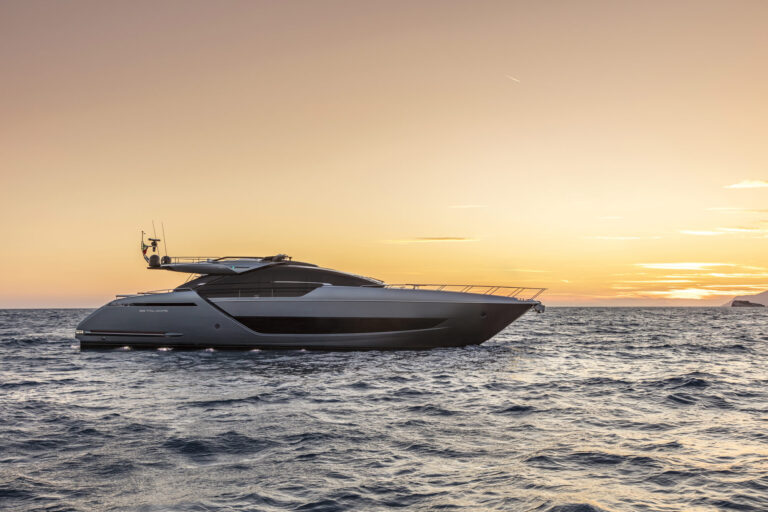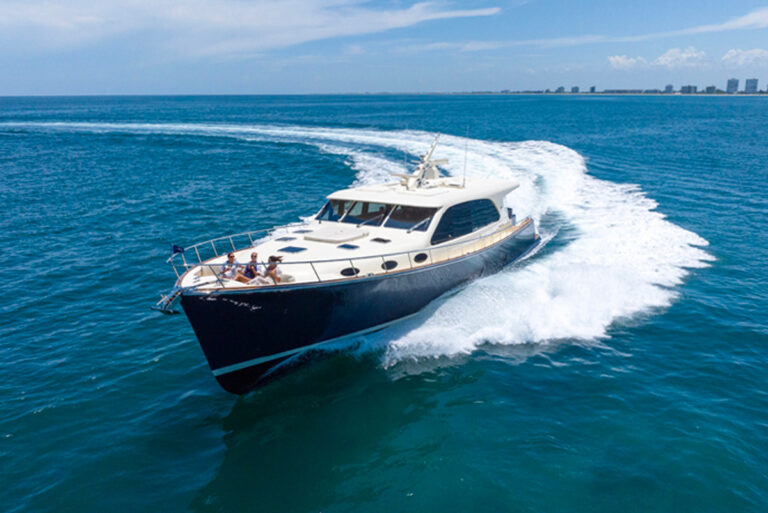I had to laugh.
Maneuvering the Selene 53 in tight quarters is laughably easy because the design team had the sense to specify a bow thruster and a stern thruster as standard. These two features are part of the scheme to market the Selene models as “mini-megayachts”. An almost obsessive attention to the details tells me the company is on the right course.
This particular example of the 53 was packed to the rafters with cruising stores and gear and was scheduled to head south for the winter the day after my visit. A final tweak of the Naiad stabilizers added a day to the preparations and opened the door for my sea trial.
The Selene 53 is a displacement motoryacht meant for long-range cruising. She’s big for her length-beamy and tall-but her shape below the waterline and single engine create a fuel-efficient package. The big slow-turning prop that goes with this combination bites substantial chunks of water with each revolution, so the yacht responds instantly to increases in throttle. I’ll wager a good helmsman could back and fill this little ship into (or out of) nearly any space that’s able to accommodate her dimensions.
We snuggled right up to the boats opposite our slip, stopped her dead, then spun her around to face the exit channel. Piece of cake. Motoring past the astonishing variety of yachts tied up at the Hinckley yard in Portsmouth, Rhode Island, the Selene’s robust Cummins 6CTA8.3M3 rumbled under its breath somewhere in the bowels of the yacht. It radiated a tactile sense of its presence more than an auditory one. Indeed, the sound in the wheelhouse at idle speed struggled to reach 60 decibels, and that was due more to the occupants’ moving around (our crew numbered seven) than the engine.
After clearing the breakwater, we turned south and headed toward the Jamestown Bridge, wind on the nose. A wind speed of about 20 knots stacked up short, steep seas of 2 to 3 feet, but the 53 treated these conditions as nothing more than a routine annoyance. Below DWL, the 53 has a fine entry and some hollow in her waterlines above the bulb. The transition to maximum beam is relatively abrupt, but the bulb fools the water into believing otherwise.
Soft chines forward sharpen to hard chines near amidships, and from there to the transom, the run stays flat, much like that of a ship. It sweeps up to let solid water flow to the prop and rudder. A keel of barely discernable drag (becoming deeper aft than forward) provides directional stability, helps damp roll and protects the prop and rudder during grounding. This flat bottom also damps roll, especially when the boat’s at rest, but it also should do so in relatively big seas taken on the beam.
Active stabilizers, such as the Naiad with Datum Controller on the Selene, take most of the drama out of heavy-weather cruising. I noticed their effect as soon as we left the harbor. The 53 heeled the tiniest bit from taking the wind on the beam, but the seas didn’t disturb her composure. The skipper made a series of long turns to port and starboard, letting the system check roll. A small display on the Naiad’s control head graphically showed the fins (71/2 square feet of surface area in each) at work, pivoting like flippers on a pinball game. All of us were surprised at how quickly they responded. When we disengaged the stabilizers, the 53 heeled outboard predictably and gently with each turn. The adaptive mode of the Naiad system lets the computer learn the boat’s characteristics in a variety of sea states. Neat.
Meticulous detail in the design and construction often spells the difference between a good cruising yacht and a great one. You’ll never want for a convenient and solid handhold aboard the Selene. I found them on the overheads, above the companionways, in the heads. Three handholds were stacked high, medium and low on the overhead in the companionway from the wheelhouse down to the galley for crew members of varying heights.
Fiddles are high, and the ones on the galley counters are molded into the Corian to prevent the inevitable leaks and damage caused to wood fiddles attached to flat Corian countertops. A lovely wooden railing guards the inboard, open side of the stairs leading from the wheelhouse to the flying bridge. The wood in this case is icing; it hides a real railing made of stainless steel. This steel core lets the railing exceed international standards for breaking strength.
In the galley, which is sensibly arranged for cooking offshore in a seaway, I found slide-out shelves behind the stove. No need to stretch over the stove. A dedicated jar/spice rack occupies a space above the counter. A Grunert holding-plate freezer drives off the engine and should provide sub-freezing temperatures when you need them, even in the tropics.
Like any intelligently designed offshore cruising yacht, the Selene 53 has its master stateroom amidships, the area of least pitching. This is a fabulous space for anyone who likes to relax in privacy, reading in bed or lounging on the settee along the port side. Two reasonably large hanging lockers, lined with cedar, should hold all the dressy clothing a cruising couple will need. I counted 12 drawers scattered about the master-under the berth and in cabinets around the perimeter. I don’t own enough clothing to fill these.
One of my favorite design elements was the foyer outside the master stateroom. Although I didn’t like the spiral staircase leading down to it (I think small spiral staircases aren’t safe), I loved having the door to the engineroom at the foot of the stairs to my immediate left. It provides ready access to the machinery from the stateroom for the owner and allows the engineer to come and go without disturbing the owner’s privacy.
The wheelhouse rekindled my case of wanderlust. Something about those reverse-rake windows makes me assume the role of “ship’s captain. The fat teak rim of the steering wheel reinforced the notion.
Even though I was piloting the Selene on Narragansett Bay, my imagination sent me offshore on a passage to the Bahamas. I watched the sky lighten on the horizon, trumpeting the arrival of Old Sol.
Contact: Ted Hood’s Portsmouth Marine Co., LLC, One Little Harbor Landing, Portsmouth, RI 02871. Ph.: 401-682-1712. www.portsmouthmarine.com.

